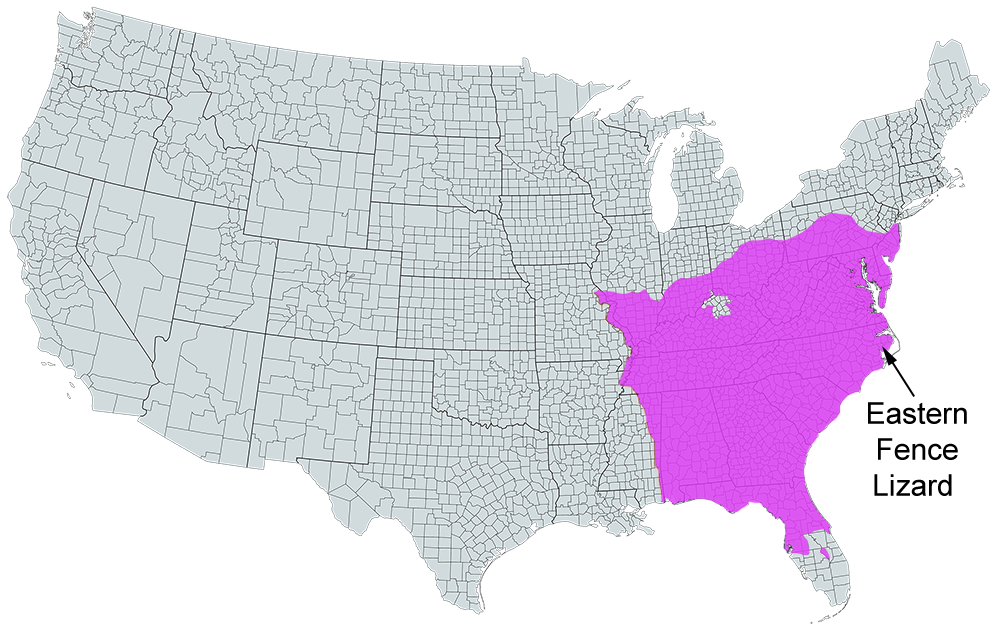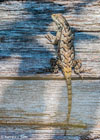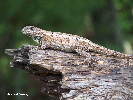Eastern Fence Lizard
Sceloporus undulatus
Common Name: |
Eastern Fence Lizard |
Scientific Name: |
Sceloporus undulatus |
Etymology: |
|
Genus: |
Sceloporus is derived from the Greek word scelos meaning "leg" and the Latin word porus meaning "hole", referring to the pronounced femoral pores found in this group of lizards. |
Species: |
undulatus is from the Latin words undulatus meaning "wave" the tus suffix means "pertaining to", in reference to the dark wavy lines on the dorsum. |
Subspecies: |
|
Average Length: |
4 - 7.2 in. (10 - 18.4 cm) |
Virginia Record Length: |
7.5 in. (19 cm) |
Record length: |
7.5 in. (19 cm) |
Systematics: Originally described as Stellio undulatus by Pierre-Andre Latreille in 1801 (in Sonnini and Latreille, 1801), based on a specimen from the "Carolinas." Smith (1938) restricted the type locality to Charleston, South Carolina. Wiegmann (1828) first used the generic name Sceloporus for this lizard group and was the first to use Sceloporus undulatus for this species. Conant and Collins (1991) illustrated the distributions of these forms. Although the generic and specific names have been stable, the subspecific name has not. S. u. hyacinthinus was described as Lacerta hyacinthina by Jacob Green in 1818 based on a specimen from New Jersey. It was first used as a subspecies of S. undulatus by Smith (1948). He pointed out that S. u. fasciatus, used by Richmond and Goin (1938) and Hoffman (1945a) in the Virginia literature, was a junior synonym of S. u. hyacinthinus.
Taxonomy for Sceloporus follows Schmidt (1953, A Check List of North American Amphibians and Reptiles, Univ. Chicago Press, Chicago) with modifications by Bell (1954, Herpetologica 10: 31–36; resurrection of S. occidentalis bocourtii and S. o. longipes), Shannon and Urbano (1954, Herpetologica 10: 189–191; proposal of S. clarki vallaris), Phelan and Brattstrom (1955, Herpetologica 11: 1–14; proposals of S. magister uniformis, S. m. bimaculosus, and S. m. transversus), Tanner (1955, Great Basin Nat. 15: 32–34; proposal of S. magister cephaloflavus), Lowe and Norris (1956, Herpetologica 12: 125–127; proposal of S. undulatus cowlesi), Maslin (1956, Herpetologica 12: 291–294; proposal of S. undulatus erythrocheilus), Smith and Chrapliwy (1958, Herpetologica 13: 267–271; proposal of subspecies of S. poinsettii), Cole (1963, Copeia 1963: 413–425; treatment of S. virgatus as a species separate from S. undulatus), Degenhardt and Jones (1972, Herpetologica 28: 212–217; proposal of S. graciosus arenicolous), Olson (1973, Herpetologica 29: 116–127; proposal of S. merriami longipunctatus), Sites and Dixon (1981, J. Herpetol. 15: 59–69; treatment of disparilis as a synonym of microlepidotus), Collins (1991, Herpetol. Rev. 22: 42–43; treatment of S. arenicolus as a species separate from S. graciosus; corroborated by Chan et al., 2013, Zootaxa 3664: 312–320), Smith et al. (1992, Bull. Maryland Herpetol. Soc. 28: 123–149; proposal of S. undulatus tedbrowni and correction of the spelling of the name S. arenicolus), Smith et al. (1996, Bull. Maryland Herpetol. Soc. 32: 70–74; treatment of S. slevini as a species separate from S. scalaris; corroborated by Bryson et al., 2012, Mol. Phylogenet. Evol. 62: 447–457 and Grummer et al., 2014, Syst. Biol. 63: 119–133), Wiens et al. (1999, Evolution 53: 1884–1897; restriction of the name S. jarrovii to one of five inferred species formerly referred to by that name), Leaché and Reeder (2002, Syst. Biol. 51: 44–68; treatment of S. consobrinus, S. cowelsi, and S. tristichus as separate species from S. undulatus), Schulte et al. (2006, Mol. Phylogenet. Evol. 39: 873–880; treatment of S. bimaculosus and S. uniformi as a species separate from S. magister and tranversus as a synonym of uniformis; see Leaché and Mulcahy, 2007, Mol. Ecol. 16: 5216–5233 for clarification of the distributional limits of those species). In Virginia only Sceloporus undulatus occurs.
Description: A moderate-sized, rough-scaled lizard reaching a maximum snout-vent length (SVL) of 86 mm (3.4 inches) and a total length of 184 mm (7.2 inches) (Conant and Collins, 1991). In Virginia, maximum known SVL is 84 mm (3.3 inches) and maximum total length is 190 mm (7.5 inches). In the present study, tail length was 45.2-64.3% (ave. = 57.4 ± 0.02, n = 152) of total length.
Scutellation: Body scales strongly keeled and pointed, overlapping, and not glossy; scale rows around midbody 26-48 (ave. = 42.7 ± 2.9, n = 139); supralabials 5/5 (76.4%, n = 140) or other combinations of 4-6 (23.6%); infralabials 6/6 (29.3%, n = 140), 7/7 (18.6%), 7/6 (27.1%), or other combinations of 5-7 (25.0%); number of femoral pores 21-36 (ave. =28.1 ± 2.4, n = 142).
Sexual Dimorphism: Females were larger (SVL 60-84 mm ave. = 70.1 ± 5.1 mm, n = 112) than males (SVL 44-73 mm, ave. =62,9 + 5.8," = 132). Sexual size dimorphism index was 0.11. Tail length, relative to total length, was shorter in females (53.7-59.7%, ave. = 56.6 ± 1.4, n = 65) than in males (45.2-64.3%, ave. = 58.2 ± 2.3, n = 77). Counts of scale rows around the midbody (40-48, ave. = 43.3 ± 2.3, n = 67), number of femoral pores (21-33, ave. =27.7 ± 2.4, n = 67), and number of crossbands (5-9, ave. = 6.6 ± 0.8, n = 68) in females did not differ from these counts in males (scale rows around midbody 40-48, ave. = 42.1 ± 3.3, n = 68; femoral pores 25-33, ave. = 28.4 ± 2.1, n = 71; crossbands 6-8, ave. = 6.6 ± 0.7, n = 59). The dorsum of males is brown to black with indistinct crossbars. Adult males possess elongated patches of hyacinth to bluish green on the venter bordered along the midline by black, and large bluish or black throat patches. Females have distinct crossbars on a gray dorsum, no bluish patches on the venter, and at most a tinge of blue on the throat.
Coloration and Pattern: Dorsum of head, body, and tail brown to gray; dorsum of body with 5-9 (ave. = 6.6 ± 0.8, n = 131) narrow, black, undulating crossbands; crossbands may be distinct or indistinct; sides light gray to dark brown or black with portions of crossbands or black flecking; tail with alternating series of light- and dark-brown rings; narrow crossbands occur on forelegs and lower hind legs; 1-2 distinct horizontal lines on rear of each thigh; parietal eye present; 1 thin black streak radiates behind each eye; venter white or cream with scattered black flecks or with 2 elongated ventrolateral patches of hyacinth to greenish blue bordered in the center by black; throat white to cream with black flecks or 2 bluish patches bordered by black; chin white; area around femoral pores may be yellowish.
Juveniles: Juveniles are patterned as adults but the crossbars are thin and may be indistinct. A pair of dorsolateral light lines may be present on some individuals. The venter and chin are uniformly white to slightly bluish. At hatching, juveniles were 24-28 mm SVL (ave. = 26.6 ± 1.1, n = 26), 51-60 mm total length (ave. = 55.5 ± 2.4), and 0.52-0.74 g body mass (ave. = 0.63 ± 0.09, based on means of four litters). Hedges (1976b) noted that eight hatchlings from Lancaster County were 22.5-24.5 mm SVL (ave. = 23.5), 47.5-51.0 mm total length (ave .= 49.5), and 0.45-0.50 g body mass.
Confusing Species: All skinks have smooth scales and are glossy. No other species in Virginia is likely to be confused with S. undulatus
Geographic Variation: There is no discernible geographic variation in scutellation, color, or pattern among Virginia populations.
Biology: The preferred habitat of Eastern Fence Lizard is xeric open pine woods and the edges of such areas. In Virginia, they occur in pine woods, mixed hardwood and pine forests, mixed deciduous forests, stands of trees in old fields, and woodlots in urban areas; along hedgerows; around barns and houses (particularly in rural and agricultural areas); and on rock piles. Access to sunlight appears to be one of the most important requirements. Perch heights for adult males (ave. for three seasons = 76-113 cm, range = 15-750 cm) in a York County mixed- deciduous woodland site were usually higher than for adult females (ave. = 48-73 cm, range = 5-900 cm) (Ross, 1982). Eastern Fence Lizards are commonly found between March and November and are diurnal. At night, lizards retreat to hiding places in tree holes, under bark, or in crevices in rock piles. Overwintering occurs in similar places. Hatchlings and juveniles emerge from hibernation earlier and enter it later than adults. Body temperatures of basking fence lizards March- September were 29.0-38.2°C (ave. = 34.5 ± 2.2, n = 28); ambient temperatures were 27.0-37.0°C (ave. = 29.7 ± 3.2). Two lizards under boards in April had body temperatures of 14.9°C and 22.0°C at ambient temperatures of 13.0°C and 19.0°C, respectively.
Eastern Fence Lizard are predators of a wide variety of invertebrates. They usually utilize the "sit-and-wait" tactic, where prey are attacked once they have been seen from a perch site. Vision is the primary sense used in prey detection. McGovern et al. (1986) found the following prey types in a sample from Henrico County: wood-boring beetles, ground beetles, leaf beetles, weevils, click beetles, rove beetles, blow flies, stink bugs, leafhoppers, ants, moths, short-horned grasshoppers, longhorned grasshoppers, roaches, spiders, millipedes, and snails. In experimental trials with adult fence lizards, carabid beetles were selected over grasshoppers and crickets because the higher activity of the beetles elicited the predatory response quicker (McGovern et al., 1986). This study also found that ground beetles were chosen over tiger beetles, apparently because of the unpalatability of the brightly colored tiger beetles. Known predators of Eastern Fence Lizards in Virginia are Northern Black Racers (Coluber constrictor), Eastern Ratsnakes (Pantherophis alleghaniensis), Northern Mole Kingsnake (Lampropeltis calligaster), Eastern Copperhead (Agkistrodon contortrix), small dogs, and domestic cats (Mitchell and Beck, 1992).
Female Eastern Fence Lizards are oviparous. Mating behavior was observed in Virginia on 19 April. Ross (1982) observed three matings in June in York County. Male recognition of the opposite sex is based on the absence of the blue ventrolateral patches (Cooper and Burns, 1987). The smallest mature male measured was 44 mm SVL and the smallest female was 63 mm. Captive egg laying was recorded between 23 June and 9 July. De Rageot (1964) found a female laying eggs naturally on 5 June. Clutch size was 6-13 (ave. = 9.4 ± 1.9, n = 23). Clutches from three Fairfax County females averaged 6.7 ± 2.1 (5-9) (C. H. Ernst, pers. comm.). Eggs averaged 13.4 ± 0.6 x 7.8 ± 0.5 mm (length 12.3-14.3, width 6.9-8.5, n = 29), and hatching occurred between 2 August and 9 September. The earliest natural record for the appearance of a hatchling in Virginia is 29 July (Dunn, 1915b).
Population sizes have not been determined for Eastern Fence Lizards in any habitat in Virginia. Brooks (1969) found that the average home-range size of adult males in James City County was 61 m2 and that of adult females was 47 m2. Growth has not been studied, but two immature females (45 mm SVL, captured in April, and 30 mm SVL, captured in August) in Lancaster County grew 19 mm in 51 days and 13 mm in 54 days, respectively (R. G. Zweifel, pers. comm.).
The display behavior of these lizards is characterized by head bobs and push ups. In a Montgomery County population, these displays were usually 4-5 seconds in duration and used in conjunction with an enlarged throat, extension of the dewlap, lateral compression of the body, and a stiff four-legged stance (Rothblum and Jenssen, 1978). These behaviors were used mostly by males when reaching a new perch site and when encountering another male or a female. A behavior called "jiggling" is a 4- to 5-second series of rapid head bobs, used in numerous contexts, that may be best interpreted as a general indicator of arousal (Rothblum and Jenssen, 1978). Roggenbuck and Jenssen (1986) showed that the behaviors of this Virginia population were almost totally innate; hatchlings possessed almost all adult display patterns.
Remarks: Other common names in Virginia are pine-tree lizard (Hay, 1902), common swift (Conant, 1945), and pine lizard (Carroll, 1950). Numerous lizards, including Sceloporus undulatus, are known to harbor the larvae of trombiculid mites (chiggers) in pockets in the skin and beneath scales (Arnold, 1986). Sites frequently infested include the axilla, groin, and side of the neck.
Conservation and Management: Eastern Fence Lizards are not a species of special concern in Virginia. Due to the amount of disturbed habitat, including open pine plantations, this species should continue to be abundant across the Commonwealth. The only concern is extirpation of local populations due to fragmentation and loss of habitat. How large a population must be to withstand chance fluctuations in population dynamics and environmental perturbations in a habitat island is unknown. To what extent does this species lose genetic variability when these populations decline? Sceloporus undulatus could be a good model on which to test some theories in conservation biology.
References for Life History
Photos:
*Click on a thumbnail for a larger version.
Verified County/City Occurrence in Virginia
Accomack
Albemarle
Alleghany
Amelia
Amherst
Appomattox
Arlington
Augusta
Bath
Bedford
Bland
Botetourt
Buchanan
Buckingham
Campbell
Caroline
Carroll
Charles City
Charlotte
Chesterfield
Clarke
Craig
Culpeper
Cumberland
Dickenson
Dinwiddie
Fairfax
Fauquier
Fluvanna
Franklin
Frederick
Giles
Gloucester
Goochland
Greene
Greensville
Halifax
Hanover
Henrico
Henry
Highland
Isle of Wight
James City
King and Queen
King George
King William
Lancaster
Lee
Loudoun
Louisa
Lunenburg
Mecklenburg
Middlesex
Montgomery
Nelson
New Kent
Northampton
Northumberland
Nottoway
Orange
Page
Patrick
Pittsylvania
Powhatan
Prince Edward
Prince George
Prince William
Pulaski
Richmond
Roanoke
Rockbridge
Rockingham
Russell
Scott
Shenandoah
Smyth
Southampton
Spotsylvania
Stafford
Surry
Sussex
Tazewell
Warren
Washington
Westmoreland
Wise
Wythe
York
CITIES
Alexandria
Chesapeake
Covington
Danville
Emporia
Fairfax
Hampton
Lynchburg
Manassas
Manassas Park
Newport News
Norfolk
Poquoson
Roanoke
Suffolk
Virginia Beach
Williamsburg
Winchester
Verified in 88 counties and 18 cities.
U.S. Range

001_small.jpg)












